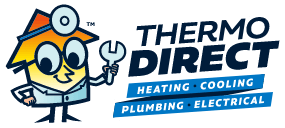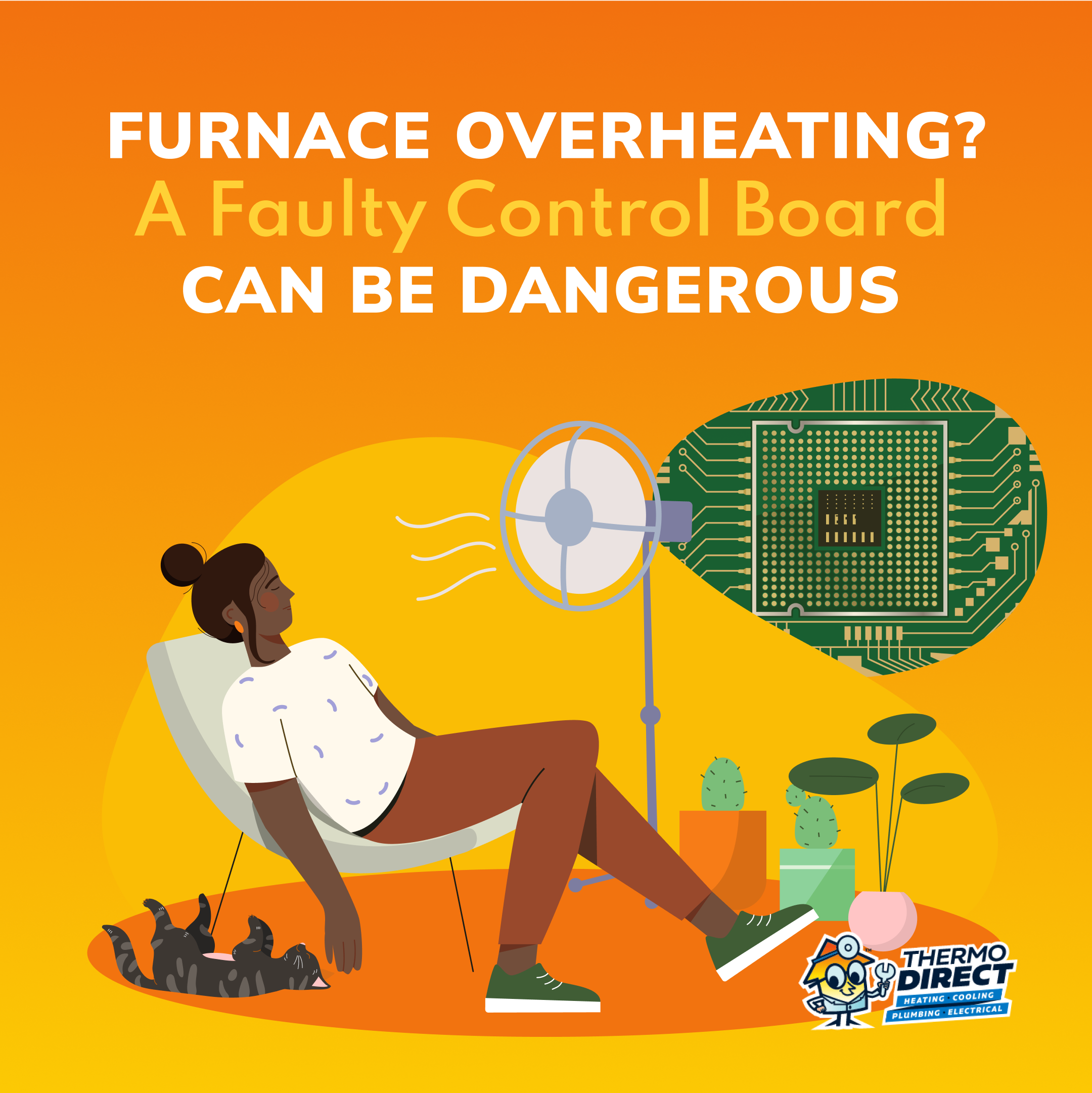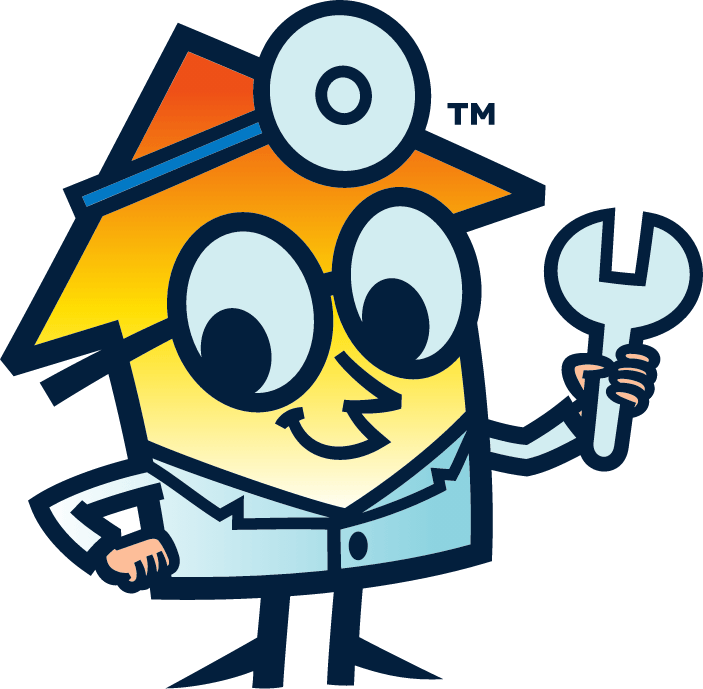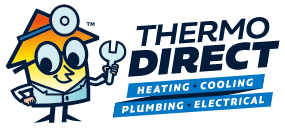Your furnace consists of complex components and mechanisms that work together to keep your home comfortable. The furnace control board is at the center of these parts, keeping each in sequence to maintain a precise balance of ignition, heating, and airflow. Learn how the control board works, how a faulty control board malfunction might be behind your furnace’s overheating and shutdown problems, and when to call Thermo Direct for furnace repair and installation services.
Understanding Your Furnace’s Control Board
The furnace control board is essentially the central computer behind your heating system. Using advanced software and electric circuitry, the control board receives and sends inputs to various attached components, such as the gas valve, motor, and ignition, to coordinate furnace functions including:
- Ignition: Signals to gas valves, igniter, and other components involved in the ignition process to ensure safely timed startup.
- Temperature regulation: Based on feedback from the thermostat and sensors, the control board monitors the temperature within your home and the furnace itself.
- Blower motor control: The control board uses temperature to determine when the blower should activate, allowing for efficiently circulated air.
- Safety monitoring: Sensors signal hazards to the control board, which shuts down the furnace to prevent overheating, damage, or other safety issues.
- Error reporting: Modern control boards often feature diagnostic capabilities, generating error codes or lights to indicate specific problems and streamline diagnosis.
By coordinating these components and functions, the control board determines when your furnace starts or stops a heating cycle. It operates with a continuous feedback loop, adjusting outputs according to constantly changing conditions.
How a Faulty Control Board Causes Overheating
Furnaces have many components and complex operations, and the control board is responsible for ensuring precise coordination. As such, even a seemingly small problem may lead to significant furnace malfunctions.
A faulty control board can cause your furnace to overheat through several mechanisms, including:
- Interrupted ignition sequence: If the control board malfunctions, it may fail to signal the gas valve to close, allowing the furnace to continue burning fuel and accumulate excess heat. Likewise, a delay in the ignition sequence leads to the burners staying on too long, contributing to overheating.
- Blower motor malfunction: Hot air may accumulate to dangerous levels within the furnace if the blower motor doesn’t receive correct inputs from the control board and can’t circulate heat properly. Erratic control board signals may also cause inefficient blower motor operation, contributing to overheating and strain on furnace components.
- Faulty sensors: If the control incorrectly translates temperature readings from sensors, it may fail to recognize when the furnace exceeds safe limits. It may also fail to trigger safety mechanisms, allowing the furnace to continue operating in unsafe conditions.
Various problems can cause control board malfunction. Power surges may damage control board parts, or dirt can accumulate around relays and prevent them from closing. Other contributing factors include overheating from blocked airflow, corrosion from moisture exposure, and short circuits from loose wiring.
Signs of a Faulty Control Board
Knowing the signs of a faulty control board helps alert you to furnace concerns, allowing you to address problems before they cause further damage. Signs of a faulty furnace control board may include:
- Unresponsive furnace
- Difficulty starting
- Burners stay on
- Fan runs continuously
- Burning smell
- Frequent cycling
- Error codes
- Inconsistent temperature
Dangers of an Overheating Furnace
An overheating furnace strains your system and prevents proper heating throughout your home, but it can also pose more significant hazards.
Excessive strain on your furnace components often leads to costly repairs and disruptive breakdowns. Occasionally, furnaces fail altogether and require premature replacement. Since furnace components are designed to withstand a limited amount of heating, overheating increases the risk of fire — for example, interrupted ignition sequences may result in combustible soot buildup that, when ignited, can quickly spread beyond the furnace.
Most significantly, overheating furnaces may cause leaks of carbon monoxide, an odorless and potentially deadly gas that’s a byproduct of combustion. Overheating can lead to a damaged or cracked heat exchanger which allows carbon monoxide to escape and circulate throughout your home.
What to Do if Your Furnace is Overheating
Overheating may trigger the safety shutoff to prevent damage. In some cases, resetting your thermostat and furnace may restore your system to normal function. Follow these steps to reset your furnace:
- Turn off the furnace from the circuit breaker, and turn the thermostat to its lowest setting.
- Clogged air filters are an easily fixed cause of overheating — check the air filter and replace if necessary to rule it out as a contributing factor.
- Turn off the main gas supply to the furnace, but leave the pilot gas supply on.
- If you have a gas furnace, relight the pilot light according to your owner’s manual instructions.
- Turn the power back on at the circuit breaker, then turn the gas on.
- Press and hold the reset button. It’s most often located at the blower motor.
- Return the thermostat to normal settings.
If your furnace won’t start or continues overheating, call a professional. Persistent overheating suggests an underlying problem with your control board or another key component and requires an experienced professional to properly diagnose and repair.
Control Board Repair vs. Replacement
When deciding whether or not to repair or replace the control board, consider the age of the furnace — if it’s relatively new, control board replacements or repairs may fall under your warranty coverage.
If the breakdown doesn’t fall under warranty, assess and compare repair and replacement costs. Replacement is often a preferred option if repairs are similarly priced. An HVAC technician can provide insight into your specific circumstances and the most cost-effective and reliable strategy.
Call Thermo Direct for Furnace Repairs
Keep your home safe and comfortable by arranging for control board repair. From maintenance programs to competitive financing, Thermo Direct offers numerous advantages to customers in Raleigh, North Carolina and surrounding areas. Get support from friendly and NATE-certified technicians today — contact us or schedule a service online.
Frequently Asked Questions
How often does my furnace need maintenance?
Furnaces generally need maintenance about once per year, ideally ahead of the heating season to ensure reliability and efficiency throughout the winter.
What should I do if I see error codes on my furnace?
Check your owner’s manual to find error code definitions. Contact an HVAC technician if you can’t decipher the code or it signals a complex problem.









